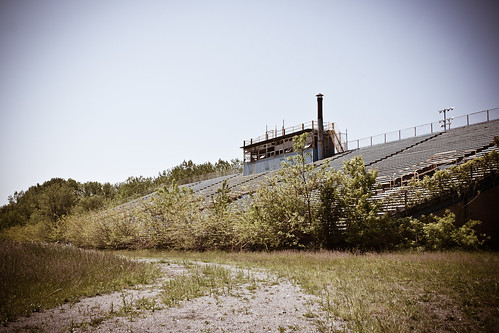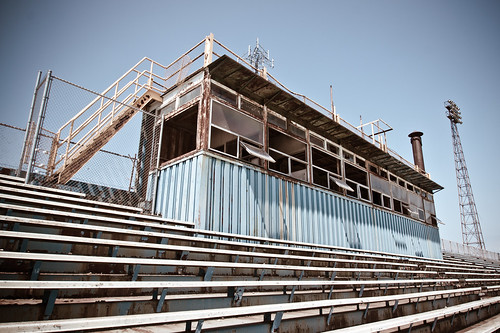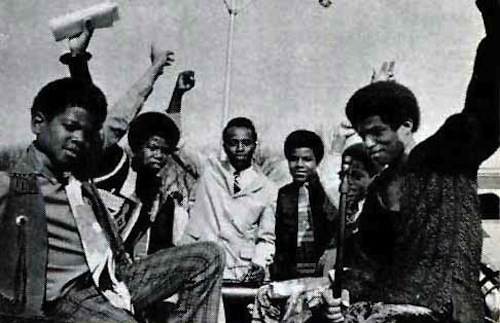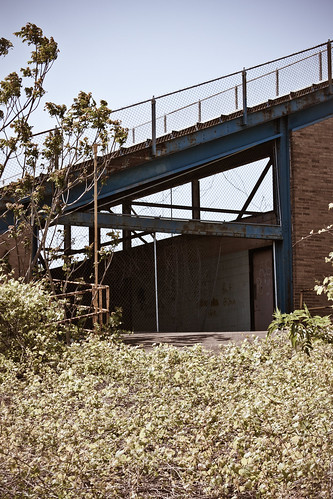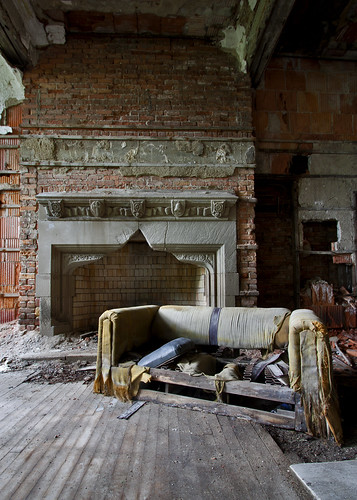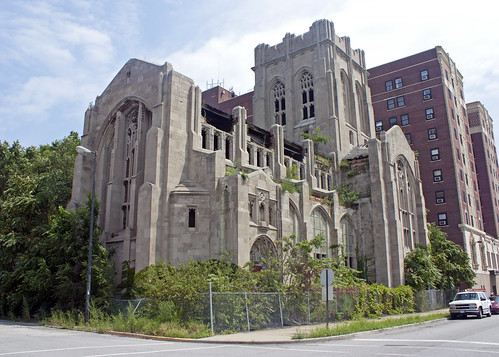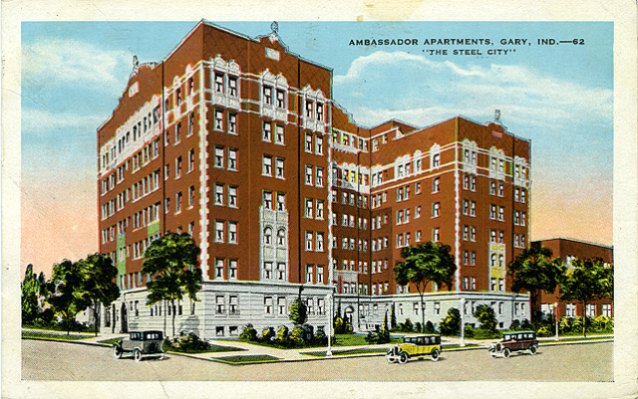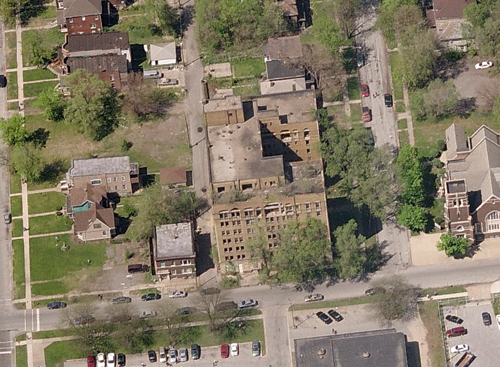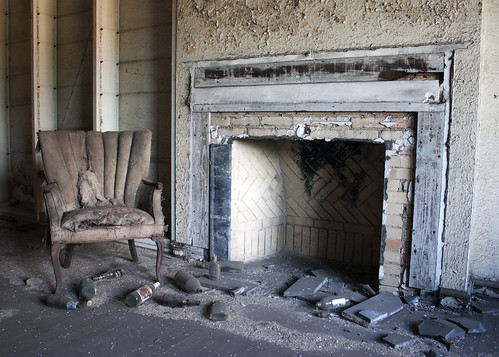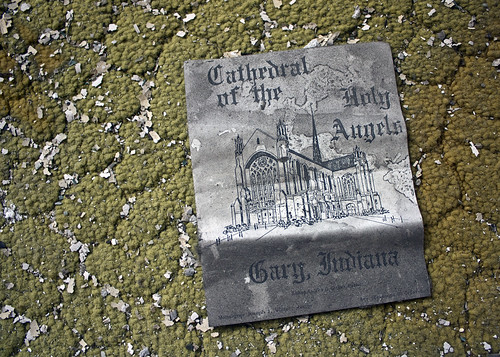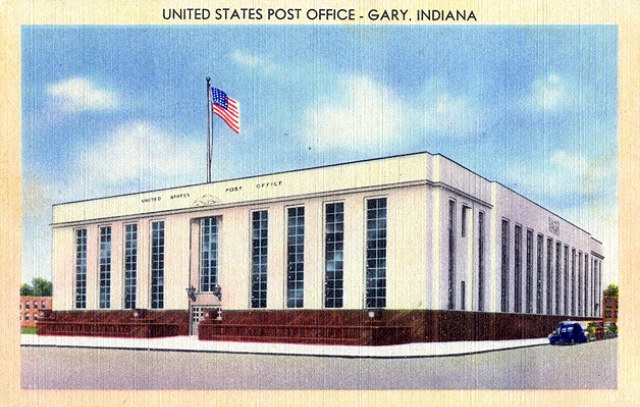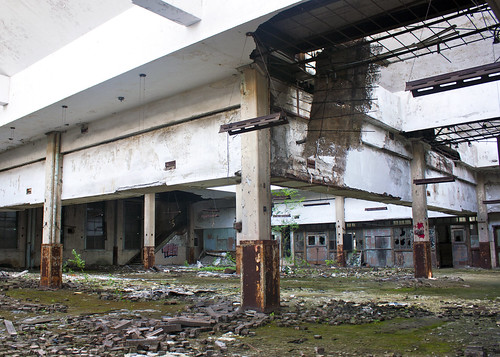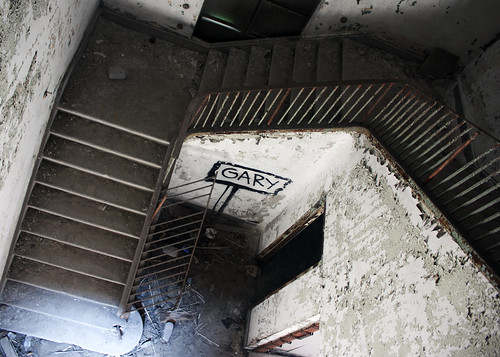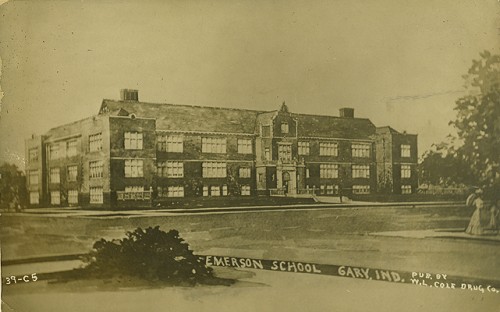
Photo (source): Emerson School as it appeared when it opened in 1909.
Americans constantly grapple with the best methods to educate children to become good citizens that contribute positively to society. Determining which facts, figures, names, dates, tests, benchmarks and statistics are significant is a battle waged on both ends of the ideological spectrum. Somewhere in the milieu we come to an agreement that there is never enough time to instruct everything in depth. Given the volume of content teachers must fit into curriculum for students to learn, many issues are drastically oversimplified. One of those unfortunate distortions is that after the Civil War the northern states continued to accept black Americans. The racially-charged history of the Emerson School on Gary, Indiana’s east side is one of those that should make you ask, “What did I really learn in school?”
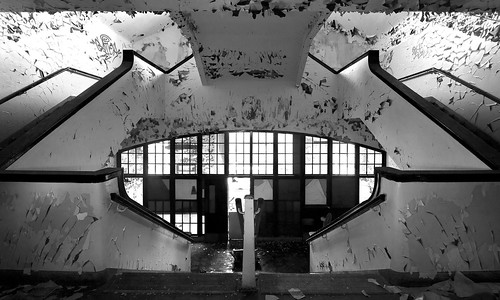
Photo: The main doorway of the now abandoned Emerson High School.
Gary’s first school superintendent, Dr. William A. Wirt, helped design the first high school in the area. Wirt brought progressive reforms to the Gary schools that modern educators would accept as the norm. Wirt’s education philosophy revolved around the idea that the “whole child” must be educated. A complete education in Wirt’s philosophy includes not only developing the intellectual, but also the social, physical, vocational and character qualities of the individual student.
The school bears the name of American transcendentalist author Ralph Waldo Emerson. The Emerson school was built to include new facilities to aid student development which included an auditorium, gymnasium, pool, and even a zoo. The new school proved to be so successful that Wirt had to implement a policy to handle the 20-30 curious daily visitors. Wirt would later reuse many design elements from Emerson in the world famous Horace Mann High School on the west side of town.

Photo (source): Emerson as it appeared in 1913.
Wirt faced a dilemma in the 1910-20’s as the city’s black population greatly increased. The East Pulaski and Virginia Street School served the black population, but were segregated and in deplorable condition. The spillover caused nominal numbers of black students to receive education in predominately white schools throughout the city, but they were limited in which facilities they could use. In the 1926-27 school year six black students attended classes at Emerson High School. To help ameliorate the student overpopulation at Virginia Street School 18 black students were transferred to Emerson in 1927.
White students outraged at the presence of more black students in their midst immediately took to the streets. On Monday, September 26 some 600 students walked out of class. Those who remained inside were heckled incessantly until they joined the throngs of protesters. As the demonstration gained momentum signs saying, “WE WON’T GO BACK UNTIL EMERSON IS WHITE. . . . NO NIGGERS FOR EMERSON. . . . EMERSON IS A WHITE MAN’S SCHOOL” taunted the black students. On Tuesday the crowd swelled to about 800 students. Wirt hedged his bets by telling the angry crowd that “possibly when a new black school was erected on the east side, Emerson would be again segregated.” At its apex on Wednesday the student protesters numbered some 1357, which were also supported by family and other local citizens who took to the street. City, school, and district officials met with protesters to begin negotiations for bringing the strike to an end. By Friday an agreement was reached: Three of the original six black students at Emerson would be transfered, while the remaining three seniors would be allowed to graduate. The 18 black students transfered into Emerson would again be transferred out to other schools. The sum of $15,000 was also allocated for temporary facilities until a new black high school could be constructed.
Mounting pressure from civic groups such as the League of Women Voters, YWCA, and Gary Teacher’s Union to desegregate schools pushed district officials to make another attempt at integration in 1945. Again, white students took to the streets en masse in an effort to curb integration. Famous crooner Frank Sinatra even scolded the protesting students for their intolerance during a concert held at the Gary Memorial Auditorium. The following year the school district adopted a new policy that dictated, “children may not be discriminated in the school district in which they live, or within the schools in which they attend, because of race, color or religion.” The policy did not take effect until the following 1947 school year to allow the community time to adjust.
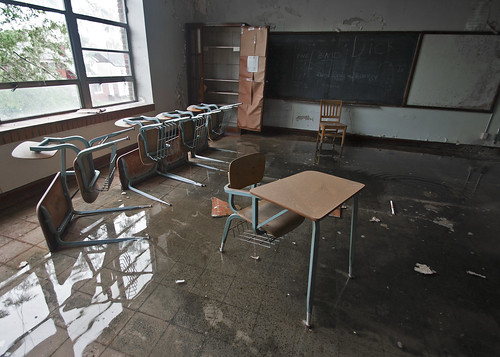
Photo: A classroom exposed to the elements swims in water.
After World War II the United States exported democracy and capitalism around the globe. As American business moved operations overseas major industrial centers began to decline. Because Emerson is a public school its fate is interwoven with that of Gary and its industry. As the population and median income plummeted, so to did revenue for Gary schools. Regular school operations continued until 1981 when low enrollment forced the school to reorganize. In 1982 the school changed its title to the Emerson School for the Visual and Performing Arts (VPA). The magnet school focused on attracting talent and fostering liberal arts skills.
Gary school district administrators faced a $23 million budget shortfall for the 2009 budget. At the time the district served about 14,000 students, which was half the enrollment 20 years prior. Consistently low test scores, high dropout rates, deplorable teaching facilities combined with an ever spiraling negative community tax base meant that hard decisions had to be made. The district decided to consolidate some of the area schools over a three year period. The writing, or mold more precisely, was on the wall for the historic building as concerned parents increasingly voiced their concern about Emerson health hazards. In 2008 the final bell rang for the Emerson building, which was just one year short of a full century of education service for the Gary community. During the transition Emerson VPA relocated to Miller Beach, Indiana. In 2011 the school returned to Gary, Indiana and currently occupies the former William A. Wirt High School building.
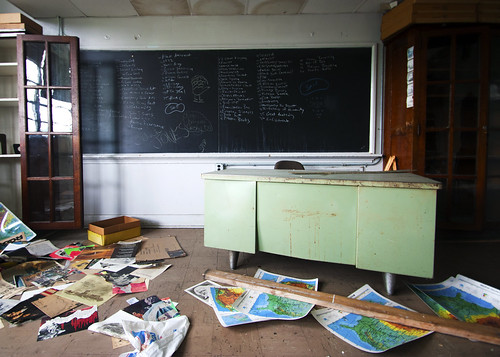
Photo: A ransacked classroom still has notes on the chalkboard from the last lesson.
The challenges of exploring the abandoned Emerson School were similar to Horace Mann High School, but were greatly intensified by inclement weather. The sky deluged the building to the point where some stairwells were inaccessible due to intense water flow. The ground floor of Emerson is set below the earth, so all water flowing within the building pooled in the ground level. The heavy cloud cover also shrouded the building in a cloak of darkness, which made setting up shots even more time consuming. The massive thunderstorm briefly subsided, only to be followed by stifling humidity. Then the storms returned in full force and set off tornado alarms. For a few moments before leaving the sun decided to peek through the clouds.
The building itself, which is on the National Register of Historic Places, is massive in scale. Wirt’s philosophies put into practice are immediately apparent when navigating the structure. The entire building revolves around the central auditorium and branches outwards. Science, math, language, music and other classrooms are easily identifiable by the decaying instructional material left behind. Even though the school had closed as recently as 2008, it felt as though Emerson was a generation behind. The only real modern artifacts found were unused textbooks still securely bound in dry storage areas. Each classroom seemed to harken back to an education generation that was no longer relevant to the modern classroom. Newspapers from decades past, Apple II computer equipment, floppy disks, vinyl records, lithographed secular songbooks and grade punchcards were stashed away all throughout. Some classrooms were filled with graffiti, while others still bear the final lesson on the chalkboard.
While considering the history and artifacts discovered on the whole Emerson can be compared to a tragic lifespan. A youthful Emerson was once daring, innovative, and eager to try new things. Mid-life struggles weighed heavily on Emerson’s soul and snuffed out the fire. In its waning years Emerson existed as a shell of its former self until finally passing. The century-old new revival style building lies dormant among a neighborhood of low-income housing and overgrown weeds.
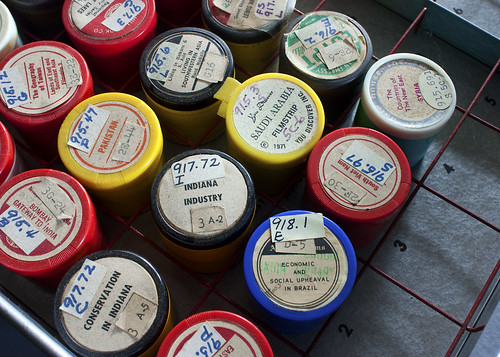
Photo: The YouTube generation will never appreciate the educational filmstrip.
In the introduction to this article I asked, “What did I really learn in school?” Although I cannot formulate an answer for the reader, I feel that sharing what I have learned from exploring Emerson is educational. While studying for my instructor’s license I became intimately familiar with the Supreme Court ruling in Brown v. Board of Education and its followup cases mandating the end of school segregation. I feel cheated that my grade and high schools boiled the segregation issue down to a base pair. It is convenient to teach that the northern United States was more tolerant and accepting of African-Americans. When the test comes it is easy to remember which bubble to fill in. As a white middle-class male I have never given the issue much weight before. In my adult life I find myself undoing a lot of the education that was force-fed. Reading books like James Loewen’s best-selling “Lies My Teacher Told Me” have been monumental in supplementing my understanding of American history.
History, race, decay and photography combined are not on the curriculum at your local school. American Urbex is willing to educate all who wish to educate themselves regardless of race, age, sex, religion or creed. He may not have known it at the time, but Ralph Waldo Emerson actually provides sage advice for the adventurous urban explorer. He says, “Do not go where the path may lead, go instead where there is no path and leave a trail.”
Photos: My collection of photos from the Emerson School.
Resources:
City Data – Emerson student and school performance statistics.
Emerson Facts – Short facts about the high school.
Emerson Homepage – The official Emerson website.
Emerson School Class of ’65 – Site dedicated to the graduating class of 1965.
Facebook – Emerson School Alumni group page.
Flickr – Nitram242’s Gary School System set has photos of Emerson.
Google Books – Details the 1927 student protests against integration.
Google Books – Photos of some of the black students that attended Emerson during 1926 and 1927.
Google Books – Has history of Gary’s East Side including EHS. Has photo of Sinatra performing at the local auditorium.
Google Books – Describes the outdoor facilities at Emerson.
Google Books – Describes the machine shop at Emerson.
Google Books – Emerson once garnered so many visitors that it had to restrict visits.
Google Books – Photo of white Emerson students protesting school integration in 1947.
Google Books – Describes industrial work education offered at Gary schools.
Google Books – Dr. Ettinger’s opinions of the training offered at Emerson in 1914.
Google Books – Has original campus plans and building history.
IEQReview – Mold discovered in Emerson in 2008.
Jen Cessa – An account of the black experience in Gary.
Journal Gazette – Announces 2008 closure and restructuring of Gary schools, including Emerson.
JSTOR – Had date of school desegregation policy. Don’t pay $9.99 for the article.
NRHP – National Register of Historic Places listing.
Purdue University (PDF) – Publication with a profile of a 2008 Emerson graduate.
Time – 1927 article on white protests against 24 negro enrollments.
Wikipedia – Entry on Emerson history.
Wikipedia – Ralph Waldo Emerson
Wikipedia – Actor Karl Malden attended Emerson.
